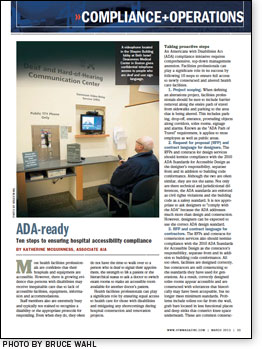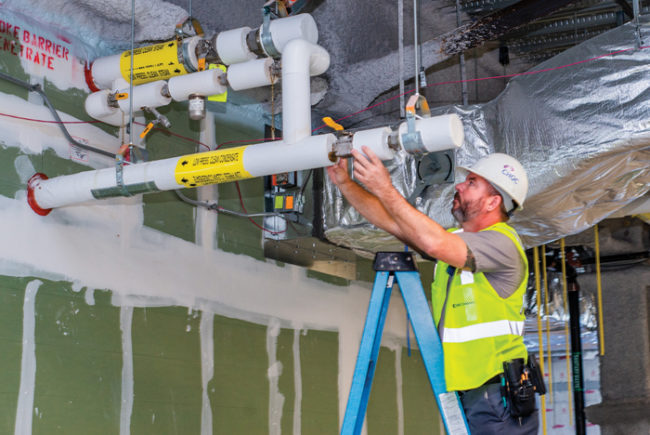 Most health facilities professionals are confident that their hospitals and equipment are accessible. However, there is growing evidence that persons with disabilities may receive inequitable care due to lack of accessible facilities, equipment, information and accommodations.
Most health facilities professionals are confident that their hospitals and equipment are accessible. However, there is growing evidence that persons with disabilities may receive inequitable care due to lack of accessible facilities, equipment, information and accommodations.
Staff members also are extremely busy and typically not trained to recognize a disability or the appropriate protocols for responding. Even when they do, they often do not have the time to walk over to a person who is deaf to signal their appointment, the strength to lift a patient or the hierarchical status to ask a doctor to switch exam rooms to make an accessible room available for another doctor's patient.
Health facilities professionals can play a significant role by ensuring equal access to health care for those with disabilities and mitigating any shortcomings during hospital construction and renovation projects.
Taking proactive steps
An Americans with Disabilities Act (ADA) compliance initiative requires comprehensive, top-down management attention. Facilities professionals can play a significant role in its success by following 10 steps to ensure full access to newly constructed and altered health care facilities.
1. Project scoping. When defining an alterations project, facilities professionals should be sure to include barrier removal along the entire path of travel from sidewalks and parking to the area that is being altered. This includes parking, drop-off, entrance, protruding objects along corridors, toilet rooms, signage and alarms. Known as the "ADA Path of Travel" requirement, it applies to most employee as well as public areas.
2. Request for proposal (RFP) and contract language for designers. The RFPs and contracts for design services should itemize compliance with the 2010 ADA Standards for Accessible Design as the designer's responsibility, separate from and in addition to building code conformance. Although the two are often similar, they are not the same. Not only are there technical and jurisdictional differences, the ADA standards are enforced as civil rights violations and the building code as a safety standard. It is not appropriate to ask designers to "comply with the ADA" because the ADA addresses much more than design and construction. However, designers can be expected to use the correct ADA design standard.
3. RFP and contract language for contractors. The RFPs and contracts for construction services also should itemize compliance with the 2010 ADA Standards for Accessible Design as the contractor's responsibility, separate from and in addition to building code conformance. All too often, facilities are designed correctly, but contractors are still constructing to the standards they have used for generations. As a result, correctly designed toilet rooms appear accessible and are constructed with tolerances that historically may have been acceptable, but no longer meet minimum standards. Problems include toilets too far from the wall, grab bars located in less functional places and deep sinks that constrict knee space underneath. These are common construction errors that create functional difficulties and can be very costly to correct.
4. Accessible design review protocols. Health facilities professionals regularly review design plans. However, there are key decisions in different phases of design that affect ADA compliance and accessibility. For example, the location of accessible parking and drop-off areas — including adequate vertical height for high-top vans — is critical at the earliest phase of garage design. In allocating clinic space, it is important to allow enough space for accessible exam rooms that will accommodate larger equipment and the additional maneuvering space required around it for the patient and staff. It is difficult to enlarge these rooms in later phases without compromising other programmatic needs. Project managers should be aware of the equipment that is being ordered for these areas. If, for example, exam tables with integrated scales are used, less space is required for standard and wheelchair-accessible scales in the clinic area. Project managers can use a list of key accessible design decision factors for each phase to avoid costly compromises later in the design process. These key decision factors could be even more successful if integrated into building information modeling and integrated project delivery processes.
5. Designing beyond minimum standards. In some cases, meeting the minimum ADA standards is inadequate. For example, they do not address bariatric design. More patients, staff and visitors require larger door widths, maneuvering space at doors and equipment as well as stronger toilets, grab bars and chairs. In addition, designing a toilet or bathing room to minimum ADA standards leaves no place for dispensers, trash receptacles and supply tables without compromising the clear maneuvering space necessary for many people. If recessed dispensers and receptacles can be used, the footprint can be smaller. However, with today's larger dispensers and trash receptacles, it is rarely possible to use recessed items. As a result, toilet and bathing rooms often need to be larger than the minimum standards. Other design features address sound and vibration, lighting levels, bed heights and communication systems within the hospital. A hospital can set its own standards for specific areas that exceed the minimum ADA standards and clearly communicate them to their design and construction teams.
6. Avoiding common errors. There are common errors in accessible design and construction that easily could be avoided if understood during the design review process. These errors include:
- Not removing barriers on the path of travel;
- Accessible parking spaces and access aisles that are not level in all directions;
- Objects such as glove and sanitizer dispensers that protrude more than 4 inches into corridors;
- Lack of visual alarms in all exam rooms, locker rooms, dressing rooms and toilet rooms;
- Heavy doors without automatic door openers;
- Toilet rooms built to minimum dimensions without room for trash or dispensers;
- Shower stalls with thresholds that patients must step over and without adequate clear floor space next to them;
- Mirrors that are mounted too high;
- Sinks that are too deep, compromising necessary clear knee space below;
- Staff locker rooms that don't have benches with backs;
- Inadequate maneuvering space in exam rooms;
- Lack of accessible equipment, including exam tables, wheelchair-accessible scales, mammography machines and beds.
7. Equipment purchasing. There are proposed guidelines for accessible medical equipment but standards are not yet enforceable. Nonetheless, the medical equipment industry is preparing to respond to requirements for accessible medical equipment such as beds, scales, exam tables, chairs and mammography machines. The clinicians and administrators who specify and procure medical equipment should be purchasing at least 10 percent of their new equipment with accessible features. In many cases, hospital staff members say the use of the accessible exam tables is a benefit to patients and employees, reducing the stress and injuries caused by lifting and transferring patients. Doctors also report being able to provide better exams. Although some accessible equipment is more expensive than new equipment, prices will become more competitive with bulk purchasing and with the market demand created by the new standards.
8. Training hospital staff. Staff members need to understand what accessible facility and equipment features are and how to use them. Otherwise, clear maneuvering space at doors may be used to store equipment; shelves and tables may be added to toilet rooms; and accessible scales may be folded up and put away because they seem to take up too much space. Facilities professionals need to work with clinical managers so administrative and clinical staff understand what is required, how new facilities and equipment should be used and the potential consequences for their patients if they are not used correctly.
9. Utilizing user-expert advisers. Some hospitals are engaging patient and family councils to advise on patient care and support. The Beth Israel Deaconess Medical Center, Boston, has developed a Universal Access Advisory Council made up of patients with disabilities and their families as well as staff who have disabilities. Council members raise issues to hospital management and make suggestions for practical solutions. In addition, they act as ambassadors to the wider community, discussing the ongoing access improvements that the hospital is implementing.
These user experts have catalyzed important decisions, including:
• Installing videophones in major lobbies to allow patients and family members who are deaf to make phone calls using video interpretation services. Privacy partitions partially enclose these phones to maintain confidentiality so calls cannot be read by others familiar with sign language.
• Purchasing and deploying wheelchair-accessible scales throughout all of the clinics in the hospital's five campuses.
• Initiating a process to identify the need for accommodations on the patient's record so that the medical assistant can easily access, prepare for and respond to them.
• Enhancing the hospital's emergency evacuation plans for persons with disabilities who are visiting and cannot use stairs. These identify areas where people can wait for assistance while out of harm's way and without blocking stairwells used by others.
• Using vibrating pagers in clinics to alert people who are deaf — or those who do not want their name called aloud — when the clinician is ready for the appointment.
10. Accessible-design punch list. At substantial completion, project managers can use a short accessible-design punch list based on common errors to check for issues that can be the difference between compliance and noncompliance and, more importantly, functional use or not.
Katherine McGuinness, Associate AIA, is founding principal of Kessler McGuinness & Associates LLC, Newton, Mass. She works with Beth Israel Deaconess Medical Center and other hospitals on ADA improvement initiatives. Her email is kmcguinness@kmaccess.com.
| Sidebar - Feds encourage barrier-free design |
| Last summer, the Department of Justice and Attorney General announced a new, joint-enforcement program called the "Barrier-Free Health Care Initiative" (www.ada.gov/usao-agreements.htm). The purpose is to ensure that persons with disabilities have access to medical information as well as physical access to medical buildings. This enforcement initiative is intended to promote voluntary Americans with Disabilities Act (ADA) compliance by health care providers nationally. The Department of Justice and U.S. attorneys are authorized to investigate and act on ADA complaints, to conduct ADA-compliance reviews and provide technical assistance. In addition, each office can initiate and intervene in litigation to ensure compliance when necessary. The initiative focuses its enforcement powers on health care organizations. This can include assessing many aspects of health care environments and services, such as facilities, diagnostic equipment, websites, parking, transportation, information in alternative formats, videophones and sign language interpreters. |
| Sidebar - Resources on the Web |
| Valuable resources to help define health facility accessibility are available online. They include the following: 2010 ADA Standards for Accessible Design:http://1.usa.gov/WKb5RP Access To Medical Care For Individuals With Mobility Disabilities: www.ada.gov/medcare_ta.htm Proposed Accessibility Standards for Medical Diagnostic Equipment: www.access-board.gov/mde/nprm.htm Disability Rights Education & Defense Fund video series: www.dredf.org/healthcare-stories Federal Access Board webinars: www.access-board.gov/webinars.htm |





